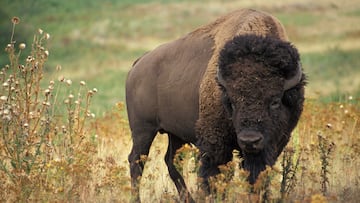Scientists discover mysterious behavior among American bison that could indicate profound ecological changes in the U.S.
Here’s how the bison population contributes to the wellbeing of the planet.


American bison are just about the craziest looking creature on planet Earth. Once nearly driven to extinction, the huge beasts are playing a key role in the fight against climate change. Their reintroduction to North America’s Great Plains is proving to be a game-changer for both biodiversity and a scientific process known as carbon sequestration.
Historically, bison roamed the plains in massive herds, cultivating the landscape through their grazing patterns, something that stopped any single plant species from dominating, keeping the ecosystem diverse.
However, the near-extinction of these beautiful creatures led to the overgrowth of certain plants, reducing biodiversity and the land’s ability to store carbon.
The American bison's near-extinction was deliberately planned by the US Army to starve Native Americans into submission
— UberFacts (@UberFacts) March 12, 2023
Colonels instructed hunters to "Kill every buffalo you can! Every buffalo dead is an Indian gone" pic.twitter.com/Phre5uEaNk
Recent studies indicate that reintroducing bison to these areas has led to a resurgence in plant diversity and soil health. Their grazing habits help cycle nutrients back into the soil, promoting the growth of a variety of plant species. This increased plant diversity enhances the land’s resilience to extreme weather events, such as droughts and floods, which are becoming more frequent due to human-induced climate change.
Moreover, bison contribute to the aforementioned carbon sequestration (the process of capturing and storing atmospheric carbon dioxide) by preventing the release of stored carbon in the soil.
The benefits of bison reintroduction extend beyond ecological improvements. Indigenous communities, such as the Eastern Shoshone tribe in Wyoming, are leading efforts to restore bison populations on their lands.
Related stories
Bill Hamilton of Washington and Lee University, explained that: “Their grazing likely has important consequences for other herbivores and for the food web as a whole, similar to the changes that occurred in the Serengeti when the wildebeest population recovered.”
Get your game on! Whether you’re into NFL touchdowns, NBA buzzer-beaters, world-class soccer goals, or MLB home runs, our app has it all. Dive into live coverage, expert insights, breaking news, exclusive videos, and more – plus, stay updated on the latest in current affairs and entertainment. Download now for all-access coverage, right at your fingertips – anytime, anywhere.


Complete your personal details to comment